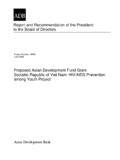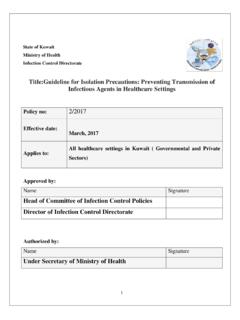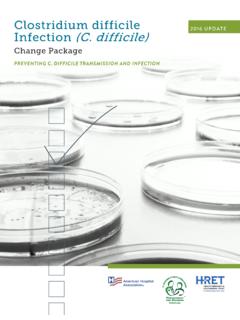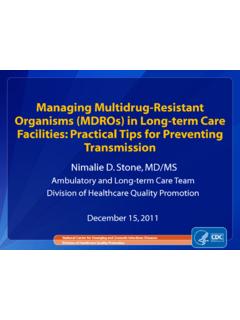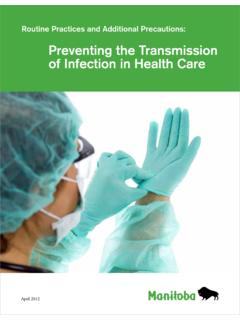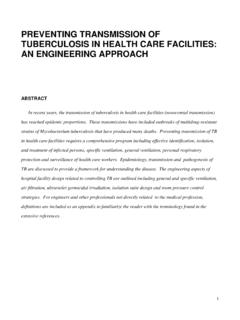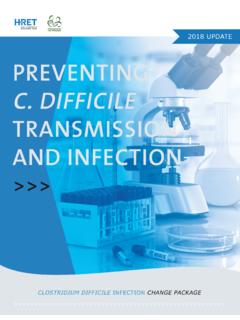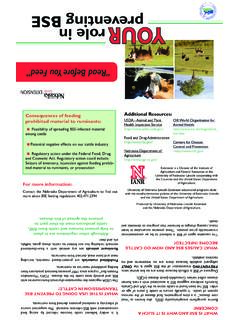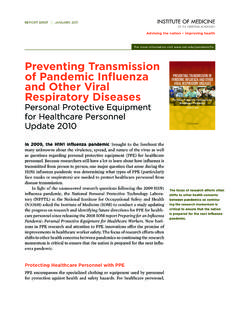Transcription of Preventing Mother-to-Child Transmission of HIV
1 Preventing Mother-to-Child Transmission OF HIVA S T R AT E G I C F R A M E W O R K This work was supported by the United States Agency for International Development (USAID) as part of Family Health International's (FHI) Implementing AIDS Prevention and Care (IMPACT) Project (Cooperative Agreement HRN-A-00-97-0017-00) and does not necessarily reflect the views of USAID or FHI. FHI implements the USAID IMPACT Project in partnership with the Institute of Tropical Medicine, Management Sciences for Health, Population Services International, Program for Appropriate Technology in Health and the University of North Carolina at Chapel Hill. June 2004 Family Health International Institute for HIV/AIDS 2101 Wilson Boulevard, Suite 700 Arlington, VA 22201 Preventing Mother-to-Child Transmission OF HIVA S T R AT E G I C F R A M E W O R K Table of Contents I. 1 II. 1 Preventing Primary HIV 2 Preventing Unintended Pregnancies Among HIV-Infected 4 Preventing HIV Transmission from Infected Women to Their 4 Improving Availability, Quality and Use of Maternal and Child Health (MCH) 5 HIV Counseling and Testing in the Context of PMTCT 5 Antiretroviral Chemoprophylaxis for 7 Infant-Feeding Counseling and Obstetric Providing Care to HIV-Infected Mothers and Their Infants and Families (MTCT-Plus).
2 10 III. FHI GOALS AND IV. FHI'S TECHNICAL AND PROGRAMMATIC Guiding FHI's Programmatic Global and Regional National Implementation Level: MCH/PMTCT Technical Counseling and Testing in ANC Antiretroviral Chemoprophylaxis and Infant-Feeding Counseling and Stigma and Research and V. ILLUSTRATIVE Fund and Provide Technical Assistance to Implement PMTCT in Fund and Provide Technical Support to Implement PMTCT Sites in Fund and Provide Technical Assistance to Implement PMTCT in Provide Technical Assistance to Implement PMTCT in Provide Technical Assistance to PMTCT Sites Funded by the Elizabeth Glaser Pediatric AIDS VI. INTERVENTION-LINKED VII. COST AND VIII. MONITORING AND IX. LINKAGES AND ANNEX X. XI. FURTHER I. INTRODUCTION Mother-to-Child Transmission (MTCT) of HIV accounts for over 90 percent of HIV infections among young children. In the absence of interventions to prevent MTCT, 30 percent of infants born to HIV-infected women will become infected during pregnancy, labor and delivery, or through breastfeeding.
3 In 2003 alone, there were an estimated 700,000 new infections and 500,000 HIV-related deaths among children under 15 years of age (1). Reported rates of Mother-to-Child HIV Transmission in the absence of any intervention are higher in developing countries (25-45 percent) than in industrialized countries (15-25 percent) (2). Offering HIV testing as part of routine antenatal care, combination antiretroviral drug regimens, and elective cesarean section and advising complete avoidance of breastfeeding has cut MTCT Transmission of HIV to below 2 percent among the limited number of HIV-infected women in developed countries. However, in the developing nations where the vast majority of HIV-infected women of childbearing age reside, MTCT rates remain high due to lack of access to feasible, affordable prevention interventions and are compounded by the nearly universal practice of breastfeeding for prolonged periods of time. Implementing prevention of Mother-to-Child Transmission (PMTCT) interventions poses significant challenges in resource-poor settings.
4 However, lessons from such diverse countries as Thailand and Uganda, where simpler but effective MTCT interventions have been tested and quickly adapted into national programs, provide evidence that services can be made available to mothers in other middle- and low-income countries. With close to 2,000 new pediatric HIV infections daily and PMTCT coverage rates as low as 1 percent in some of the countries most affected by HIV/AIDS, the rapid scale-up of PMTCT interventions must be considered an emergency effort. In June 2001, the United Nations General Assembly Special Session on HIV/AIDS (UNGASS) declared its commitment to reducing the proportion of HIV-infected infants by 20 percent by 2005 and by 50 percent by 2010. Global commitment to increase access to care and treatment for persons infected with HIV, including the government s Presidential Emergency Plan for AIDS Relief (PEPFAR) and the World Health Organization s 3 by 5 initiative, is growing, and PMTCT is a critical point of entry to care, particularly for HIV-infected women and their families.
5 This paper outlines Family Health International s (FHI) evidence-based strategy and its efforts to rapidly scale-up PMTCT interventions in resource-constrained countries. II. STATE-OF-THE-ART PMTCT INTERVENTIONS Scientific progress in understanding MTCT, the availability of specific interventions to prevent MTCT and collective international experience over the last decade have provided better opportunities to reduce the number of children born with HIV worldwide. To significantly impact the pediatric HIV epidemic, the World Health Organization (WHO) and the United Nations (UN have articulated a comprehensive, four-pronged strategic framework for Preventing Mother-to-Child Transmission of HIV: 1 1. Prevent primary HIV infections 2. Prevent unintended pregnancies among HIV-infected women 3. Prevent Transmission of HIV from infected women to their children 4. Provide care for HIV-infected mothers and their infants and families (known as PMTCT-Plus) (3) The simultaneous implementation of all four prongs of PMTCT at all levels in an environment that challenges and works to combat stigma and discrimination provides the only real hope for achieving international goals for PMTCT.)
6 Figure 1 below shows the four prongs and some examples of specific strategies for each. Figure 1: The Four Prongs of a Comprehensive Program to Prevent MTCT Prong 1: Prevent primary HIV infection Implement behavior change interventions Improve sexually transmitted infection management Make the blood supply safe Address contextual factors that increase women s vulnerability to HIV ( , economic dependency, schooling, etc.) Prong 2: Prevent unintended pregnancies among HIV-infected women Provide family planning information and counseling to assist in decision-making Integrate contraceptive services into voluntary counseling and testing Strengthen linkages between FP & HIV services Ensure access to safe FP options Prong 3: Prevent Transmission of HIV from infected women to their children Implement interventions to reduce Transmission during pregnancy, labor and delivery Implement interventions to reduce Transmission through breastfeeding Prong 4.
7 Provide care for HIV-infected mothers and their infants and families (PMTCT-Plus) Ensure screening for, prophylaxis and management of opportunistic infections Offer antiretroviral treatment Provide nutrition care and support services Provide sexual and reproductive health counseling and support, including family planning services Prevent and treat reproductive tract infections and sexually transmitted infections Offer symptom management and terminal care Provide mental health and psychological support services Offer social support 1. Preventing Primary HIV Infection Preventing HIV in women, particularly young women, and their partners is the best way to ensure that secondary Transmission to infants does not occur. The majority of HIV infections around the world are among young people age 10 to 24. Girls and young women account for most new infections among this age group, and the majority of women attending MCH clinics for pregnancy-related care are 15-to-24 years old.
8 During these years, youth learn, explore and make decisions that will affect the rest of their lives. Without the information, skills and services they need to make informed choices, young people are more 2 likely to engage in risky behaviors that result in high rates of sexually transmitted infections (STIs), including HIV, and early and unintended pregnancies. By recognizing that youth are a complex group requiring segmenting based on age, gender, geographic setting, family, school and civil status, and special needs, interventions have enormous potential to turn the tide of HIV infections among youth, and ultimately to reduce Mother-to-Child Transmission . A range of HIV prevention and broader community development initiatives including behavior change communication (BCC) programs such as peer education targeting in-school and out-of-school youth are underway in many countries. Other strategies include providing information through channels that young people enjoy the media, theater, live arts and technology and through anonymous sources such as hotlines and the internet.
9 Enrolling and keeping girls in school also has been directly linked to delaying the start of sexual activity and Preventing HIV infection. Another approach to Preventing primary HIV infections is through large-scale STI interventions. STIs are linked to HIV since similar behavior puts people at risk for both. Thailand reduced the incidence of curable STIs by more than 80 percent in less than five years through a comprehensive effort that included improved STI treatment and targeted promotion of condom use among sex workers. At the same time, HIV prevalence, which had been increasing rapidly, began to fall. FHI advocates strategies that strengthen the public health response to STIs, improve the quality of STI preventive and curative services, extend effective and appropriate interventions to groups with the highest STI exposure, and selectively implement focused measures to rapidly reduce the prevalence of specific STIs. Examples relevant to PMTCT include globally implemented, improved case management of genital ulcer disease and strengthened antenatal services to screen and treat pregnant women for latent syphilis infection using existing affordable technology.
10 It is programmatically easier to integrate PMTCT interventions into MCH settings where essential services such as syphilis screening, treatment and partner notification are already in place. Conversely, adding PMTCT interventions presents an opportunity to improve and strengthen essential MCH services, including syphilis screening and treatment. Syphilis screening and treatment directly benefit women and their partners regardless of their HIV status, reduce perinatal morbidity and mortality, and prevent HIV. However, present approaches to managing vaginal discharge syndromes are less accurate, and better combinations of syndromic and laboratory diagnosis and screening are needed. Addressing men is also a key component of STI and HIV control. Several observational studies have found a relationship between HIV voluntary counseling and testing services and reductions in risky sexual behaviors and increases in condom use. A muti-center randomized controlled study conducted by FHI, UNAIDS and WHO confirmed these findings (4).

